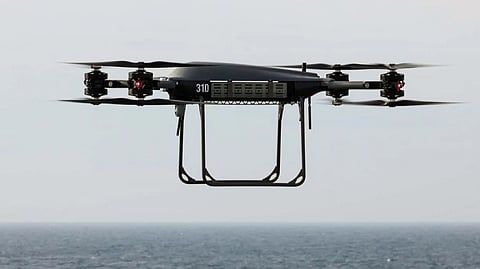Royal Navy to trial drones for transporting supplies between ships
For the first time a fleet of drones will fly crucial supplies between ships of the UK Carrier Strike Group of the Royal Navy when it deploys to the Indo-Pacific later this month.
Alongside F-35B Lightning II stealth jets and naval helicopters, the air group of flagship HMS Prince of Wales will also consist of nine cargo drones for remotely moving items – food, packages from home and engineering parts – around the task group on its mission east.
The Royal Navy said the trial of the new systems alongside crewed aircraft is intended to free up the air group's more expensive helicopters to focus on their primary role of protecting the task force on its mission to the Far East.
Drone specialist unit 700X Naval Air Squadron (700X NAS) from Royal Navy Air Station Culdrose will embark a team of 12 sailors to operate nine air systems, initially from three ships in the group to test the capability.
"There is a statistic from previous carrier strike deployments that shows 95 per cent of stores transferred weigh less than 50 kg," said Lieutenant Matt Parfitt, a drone flight commander with 700X NAS. "They could be anything from parcels from home to a vital engineering part.
"In the past we’d have used a helicopter if a part was urgently needed on another ship. This time we’re going to use a remotely-piloted, uncrewed system instead."
Each drone to be used for the trials has eight rotor blades, an endurance of between 20 and 40 minutes, and the ability to lift up to 68 kg. It needs a team of two, one remote pilot and a second to monitor the drone's command unit, and it can be flown manually or autonomously to designated waypoints even with underslung cargo.
Built by private company Malloy, the new drones were created as a result of a research and development project led by the Ministry of Defence to accelerate its use of new technology.


